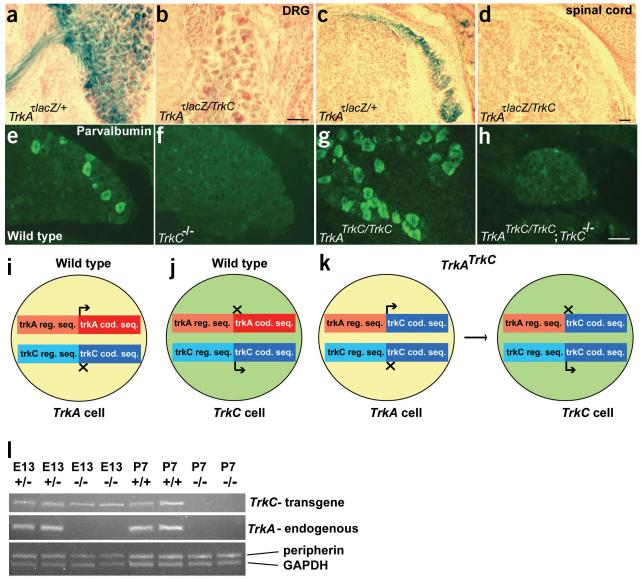Figure 5.
Mechanism of the phenotypic switch in TrkATrkC/TrkC mice. (a-d) LacZ-derived activity is apparent in cell bodies (a) and central projections (c) of nociceptive-thermoceptive neurons in mice carrying a single copy of TrkAτlacZ. This staining is absent in TrkAτlacZ/TrkC compound heterozygous mice (b,d). (e-h) In situ hybridization analysis shows that DRG neurons from TrkATrkC/TrkC;TrkC-/- double homozygous mice do not express the proprioceptive marker parvalbumin (h), similarly to TrkC-/- mice (f), indicating that endogenous TrkC is required for the phenotype observed in TrkATrkC/TrkC mice (g). (i-k) A model of the mechanism underlying the phenotypic switch described in this study. Neurons in TrkATrkC/TrkC mice that initially activate the TrkA promoter now instead express TrkC. This leads to a Trk switch, including the downregulation of the TrkA promoter and upregulation of the endogenous TrkC promoter. (l) Levels of TrkC transgene expression were assessed by semiquantitative RT-PCR at two different time points. GAPDH and peripherin transcripts were used as controls for the cDNA samples. Consistent results were obtained in three different experiments. In agreement with the above model, the transgene was expressed at E13.5 in both TrkATrkC and TrkATrkC/TrkC mice. Postnatally, the transgene was expressed in heterozygous, but not homozygous, mice. TrkA was absent in all homozygous samples, as expected.

